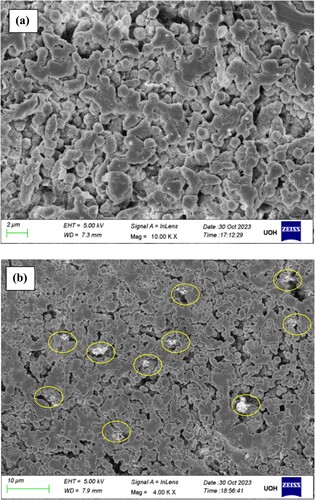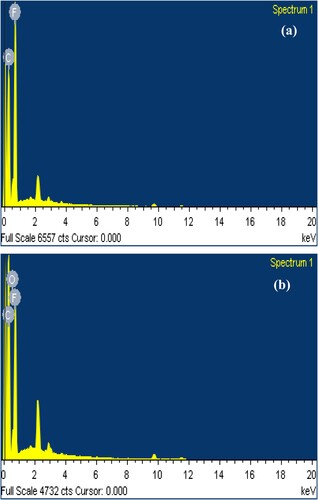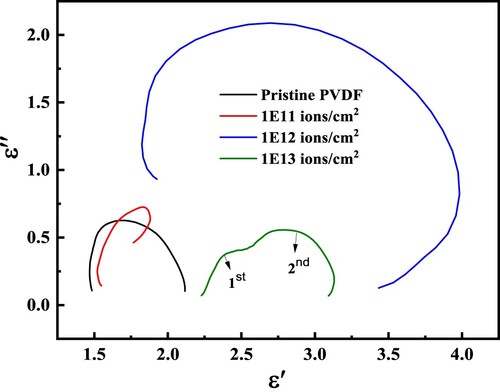 ?Mathematical formulae have been encoded as MathML and are displayed in this HTML version using MathJax in order to improve their display. Uncheck the box to turn MathJax off. This feature requires Javascript. Click on a formula to zoom.
?Mathematical formulae have been encoded as MathML and are displayed in this HTML version using MathJax in order to improve their display. Uncheck the box to turn MathJax off. This feature requires Javascript. Click on a formula to zoom.Abstract
Polyvinylidene fluoride (PVDF), with β polymorph, is a versatile ferroelectric polymer in device fabrication. Its flexibility, lightweight, and ease of fabrication make it an alternative for electromagnetic interference shielding effectiveness (EMI-SE) improved through swift heavy ion (SHI) irradiation. For the first time, we modified PVDF thin films for EMI-SE applications, exposing them to a 100 MeV oxygen ion beam at varying fluencies. Our analysis encompassed investigating structural study, bonding interactions, surface morphology, and elemental analysis using X-ray diffraction (XRD), Fourier transform infrared spectrophotometry (FTIR), and Field Effect Scanning Electron Microscopy (FESEM) with Energy Dispersive X-ray Spectroscopy (EDS) respectively. Further, we measured dielectric response, cole-cole plot and EMI-SE in Ku-band (12–18 GHz) region using a vector network analyzer (VNA). The results revealed distinctive variations due to the deposition of 100 MeV oxygen ion beams, emphasizing the significant potential of irradiated PVDF thin films for EMI-SE applications. This study contributes to understanding the transformative impact of ion beam exposure on PVDF thin films and highlights their practical promise in emerging technological applications, particularly in EMI-SE.
1. Introduction
Polyvinylidene fluoride (PVDF), a semi-crystalline thermoplastic fluoropolymer derived from vinylidene difluoride polymerization, exhibits five phases, with the β-phase renowned for its remarkable pyro-, piezo-, and ferroelectric properties (Citation1, Citation2). Noteworthy for its lightweight composition, mechanical flexibility, and ease of processing, the β-phase attracts significant interest (Citation3).
Advancements in polymer modification through irradiation are rapidly progressing, offering technological benefits ranging from nuclear radiation insulators to applications in satellite electronics, nuclear waste facilities, and military electronic missiles (Citation4–6). Recognizing the substantial degradation along particle tracks caused by heavy charged particle passage through a polymer, especially in SHI irradiation with MeV energy, the primary electronic energy loss creates elongated, straight columnar tracks with high ionization density (Citation7, Citation8).
The increasing prevalence of electronic devices and wireless technology raises concerns about Electromagnetic Interference (EMI), leading to malfunctions, data corruption (Citation9, Citation10), and potential health issues (Citation11). Traditional shielding methods face challenges such as weight, corrosion, poor dielectric traits, complexity, and cost (Citation12, Citation13).
Ferroelectric Polymer PVDF thin film provide a solution with their lightweight, thin, sturdy, and flexible nature, coupled with high absorption, non-corrosiveness, excellent dielectric properties (Citation14), wide frequency range, high conductivity (Citation15, Citation16), easy processing, and cost-effectiveness (Citation17, Citation18). These materials show promise not only in EMI shielding (Citation19, Citation20) but also in applications such as sensors (Citation21, Citation22), supercapacitors (Citation23), energy storage (Citation24), and batteries (Citation25). Nanocomposite films emerge as a potent choice for EMI shielding and a range of multifaceted applications.
This study examines the effects of 100 MeV 16O7+ ion irradiation on PVDF thin films, revealing reduction in crystallite phases, cross-linking effects, and amorphization. Exploring both unirradiated and post-irradiated samples, the research emphasizes the material's behavior under extreme conditions. It addresses the need for EMI-SE alternatives, aligning with challenges faced by traditional methods. The potential applications of PVDF-based nanocomposites, prized for their lightweight and flexibility, offer promising solutions. The study implies the underexplored potential of PVDF, particularly its β-phase, enhancing its originality and significance.
2. Experimental details
2.1. Materials and method
PVDF granules (Mw = 534,000) procured from Sigma Aldrich, India, and N, N-Dimethylformamide (DMF) AR grade from Spectrochem. Pvt. Ltd., Mumbai, India, were utilized for the preparation of PVDF thin films.
2.2. Preparation of PVDF thin film and irradiation technique
Figure outlines the process of preparing a PVDF thin film using the solution casting method with a thin film applicator. 2 g of PVDF granules were dissolved in 15 mL of DMF, stirred for 3 hr at 50 °C, and sonicated for 30 minutes to ensure uniform density. The resulting solution was poured onto a glass sheet, and immersed in cold-distilled water bath for phase inversion, and the resulting thin film was wisely peeled off. The film had a thickness of 210 ± 10 µm measured using a digital gauge meter and dimensions of 14 cm x 5 cm. Using SRIM-2008.04 software, the range of 100 MeV Oxygen ions in the PVDF film was estimated at 161.61 µm, thinner than the prepared thickness.
The ion beam irradiation experiment occurred at the Inter University Accelerator Centre in New Delhi, using the 15 UD Pelletron accelerator. PVDF thin films were exposed to a 100 MeV 16O7 + ion beam, covering a 2 cm width and vertically scanned across a 1 cm area to generate larger irradiated samples in a stainless steel chamber maintained at a high vacuum of 2.8 × 10−6 Torr. The ion beam, with a 1.43 pnA beam current, was sustained for the necessary duration to achieve fluencies of 1011, 1012, and 1013 ions/cm2.
2.3. Characterization
The structure of the pristine and O-irradiated PVDF films was investigated using the Bruker AXS D8 Advance X-ray diffractometer with Cu-Kα radiation (λ = 1.5418 Å). Data were recorded for 2θ ranging from 10° to 90° with steps of 0.2107° at room temperature. Fourier transform infrared (FTIR) spectrophotometry (Perkin Elmer Spectrum Two L160000U) was employed to analyze the chemical bonding interactions within the wavelength range of 400 to 4,000 cm−1. The surface morphology and elemental analysis were studied by FESEM with EDS using Carl Zeiss (ultra 55). The assessment of EMI shielding properties was carried out using a two-port vector network analyzer (Agilent E8361C, USA) operating within the Ku-band. Calibration of both the instrument and waveguides was performed using the Through-Reflect-Line (TRL) calibration technique. The thin film samples were mounted into the waveguide sample holder, aligning with the dimensions of the waveguide, for the measurement process.
3. Result and discussion
3.1. X-ray diffraction analysis
Figure illustrates the X-ray diffraction pattern of pristine PVDF and 100 MeV 16O7+ ion irradiated thin films at three various fluences. The low intense diffraction peaks recorded at 2θ = 18.46° and 26.53°, corresponding to (020) and (022) planes respectively, represent the α-phase of pristine PVDF. Additionally, the presence of high intense characteristic peak at 2θ = 20.17° and low intense peak at 2θ = 36.34°, linked to (110) and (200) planes respectively, indicates the existence of the dominant β-phase of pristine PVDF (JCPDS No.00-038-1638). The XRD pattern of irradiated PVDF samples reveals the absence of 2θ peaks at 18.46° and 26.53°, indicating the depletion of the α-phase PVDF due to ion irradiation. Additionally, a shift in the peak from 2θ = 20.32° to 19.88° and 41.13° to 39.45° indicative of the β-phase of PVDF, is ascribed to modifications induced by 100 MeV O- irradiation on the PVDF lattice (Citation26–28). The prevalence of the ferroelectric β phase in O- irradiated PVDF thin films is distinctly visible in the XRD patterns. Furthermore, irradiated PVDF samples exhibits new peaks at 2θ = 56.41° and 61.82° is potentially associated with secondary radiation-induced crystallization (SRIC), representing the appearance of a novel crystallization phase in PVDF polymer (Citation29). Notably, high-energy ion irradiation leads to polymer chain contraction, enhancing polymer density and fostering the creation of new crystallite regions through chain-folding and cross-linking in the polymer (Citation30). The estimated lattice strain, crystallite size, and dislocation densities are tabulated in Table .
Figure 2. XRD patterns of pristine and 100 MeV 16O7+ irradiated PVDF thin films at three different fluences.
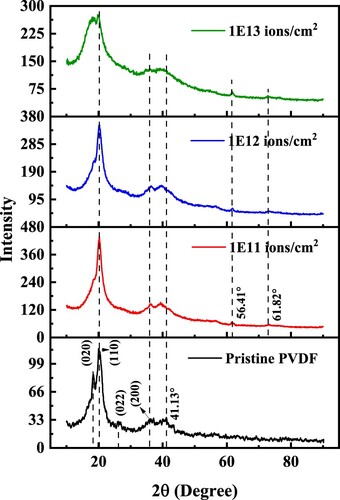
Table 1. Crystallite size, Dislocation density, and Lattice strain of samples before and after irradiation.
3.2. FTIR analysis
Figure depicts the FTIR spectra of pristine and 100 MeV O- irradiated PVDF thin films at room temperature. In the pristine PVDF thin film, characteristic peaks of the α-phase manifest at 612 cm−1 (CF2) and 763 cm−1 (CF CH–CF). The peaks at 796 and 872 cm−1 (CH2), 1071 (CH2), and 1454 cm−1 denote the PVDF β-phase. The presence of a shoulder at 841 cm−1 (CH2 and CF2) is ascribed to the β and γ-phases of PVDF (Citation31, Citation32). Hence, all three phases: α, β, and γ are discernible in the pristine PVDF. Following irradiation, the FTIR spectra reveal conformational alterations in PVDF. A reduction in peak intensities (notably, bending and rocking vibrations of CF2 groups around 612 and 796 cm−1, respectively) is observed with increasing fluence. This reduction signifies the realignment of dipoles within the polymer, forming ordered cross-linked molecular chains and crystallites (Citation33). This observation confirms with the FESEM analysis, which illustrates the development of a grain-like structure in irradiated PVDF.
3.3. FESEM with EDS analysis
Figure presents the FESEM images of both pristine and 100 MeV 16O7+ ion irradiated PVDF thin films, depicting valuable insights into their microstructure and surface morphology. These images reveal the distinctive structural attributes of PVDF, showcasing features like spherulites and fibrillar structures, while illustrating the arrangement of crystalline and amorphous regions. The pristine PVDF sample exhibits a smooth surface (Figure (a)), whereas the irradiated sample (Figure (b)) displays the formation of an amorphous phase around the impact area and the development of a grain-like structure throughout the PVDF, attributed to the linear energy transfer (LET) effect caused by heavy ions via electronic energy loss (Citation34).
FESEM combined with Energy Dispersive X-ray Spectroscopy (EDS) stands as a robust technique for elemental composition analysis in materials. In Figure (a), the spectrum's peaks correspond to characteristic X-rays emitted by carbon and fluorine elements present in the pristine PVDF sample, exposed to high-energy electrons in the FESEM. Similarly, Figure (b) shows peaks in the spectrum corresponding to characteristic X-rays emitted by carbon, fluorine, and oxygen elements in the irradiated PVDF sample for a higher fluence of 1013 ions /cm2, dipicted by high-energy electrons in the FESEM. Table provides the weight percent and atomic percent of elements in both pristine and irradiated samples. Notably, EDS microscopy can't detect elements with atomic weights below four, hence hydrogen remains undetected in the spectra. The minor peaks in both spectra stem from gold sputtering applied to the samples.
Table 2. Chemical composition of pristine and O- irradiated PVDF thin films.
3.4. Microwave dielectric properties analysis
The frequency-dependent behaviour of complex permittivity and complex permeability within the Ku-band range is depicted in Figure . Microwave absorption properties are simulated based on the complex permittivity (ϵr = ϵ′ - jϵ′′) and complex permeability (µr = µ′ - jµ′′), utilizing the transmission line theory for reflection loss calculations. From Figure (a), the maximum value of real part of complex permittivity (ϵ′) is found to be higher beyond 17 GHz for the sample irradiated with a fluence of 1013 ions/cm2 and imaginary part of complex permittivity (ϵ′′) is minimum above 17 GHz for the same sample. Figure (b) illustrates a decreasing trend for all samples in the ϵ′′ vs frequency plot. Since µ′ and µ′′ for non-magnetic materials are considered as 1 and 0, respectively (Citation35, Citation36), it can be inferred that microwave absorption is dominated by dielectric loss, contributed by polarization and conduction losses. Debye's theory of dielectric relaxation elucidates the diverse processes governing the attenuation of electromagnetic waves. The relative complex permittivity () serves as a tool to comprehend the dielectric loss mechanism in microwave absorbers. It can be expressed as follows,
(1)
(1) Therefore, ϵ′ and ϵ′′ can be derived as
(2)
(2)
(3)
(3) The aforementioned relationship demonstrates that ϵ′ arises from the diverse polarization mechanisms within the material. Likewise,
accounts for the contribution from both polarization and conduction loss mechanisms. As per Equations (2) and (3), when the contribution from the conduction aspect is negligible, the relationship between ϵ′ and ϵ′′ can be characterized as follows.
(4)
(4)
Figure 6. Variation of complex permittivity (a) real and (b) imaginary parts of pristine and O-irradiated PVDF thin films with three different fluences
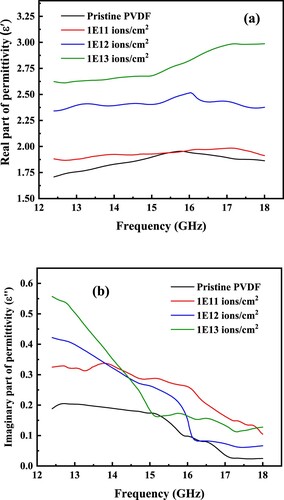
Consequently, the plot of ϵ′ vs. ϵ′′ shapes a semicircle commonly known as the Cole−Cole plot, with a radius of and centred at
. Furthermore, this semicircle typically corresponds to a singular dielectric relaxation process (Citation37). In Figure , the Cole-Cole plots of pristine and O-irradiated PVDF thin films with three fluences are shown. Pristine PVDF and the film irradiated with fluences of 1011 and 1012 ions/cm2 display singular semicircles representing Debye dipole relaxation processes, demonstrating frequency dispersion effects of dielectric loss with resonance peaks. However, for the film irradiated with a high fluence of 1013 ions/cm2 two semicircles indicate Debye dipole relaxation processes, suggesting the presence of Maxwell–Wagner relaxation and dipolar polarisation. Consequently, Debye’s relaxation polarization, interfacial polarization losses collectively contribute to the dielectric loss capability of the O- irradiated PVDF film (Citation38).
3.5. EMI shielding property analysis
The overall shielding effectiveness is the combined impact of net shielding through reflection (SER), absorption (SEA), and multiple reflections (SEM). The contribution of multiple reflections becomes insignificant when the shielding effectiveness (SE) achieved by the material surpasses -10 dB in higher frequencies (GHz). The total shielding effectiveness (SETotal) can be determined using the measured scattering parameters through the following equations:
(5)
(5)
(6)
(6)
(7)
(7) where S11, S22, S12 and S21 are the magnitude of the scattering parameters (Citation39).
Figures illustrate frequency-dependent changes in EMI-SE for both as-prepared and O-irradiated PVDF thin films within the 12–18 GHz (Ku-band) range. The pristine PVDF film exhibits a maximum EMI-SE of 0.27 dB, while films O- irradiated with 1011, 1012, and 1013 ions/cm2 show maximum EMI-SE values of 0.43 dB (59.2%), 0.52 dB (92.6%), and 0.81 dB (200%), respectively, at 12.4 GHz. The data demonstrate that EMI-SE increases with fluence and decreases with frequency. Beyond 16 GHz, EMI-SE plots for all samples converge due to dipole polarization hindrance. O-irradiated PVDF thin films at various fluences result in observable swelling (refer to Table ). Increased fluence leads to a decreasing percentage change in thickness, attributed to amplified dislocation density and ion-induced alterations, affecting polymer density and apparent thickness. The observed increase in total EMI-SE goes beyond film swelling, resulting in the dominant effect of dielectric loss. These findings contribute to our understanding of the intricate interplay between dielectric properties and irradiation-induced changes, offering valuable insights for applications in electromagnetic interference shielding.
Figure 8. Total EMI shielding capability of pristine and O- irradiated PVDF thin films with three different fluences.
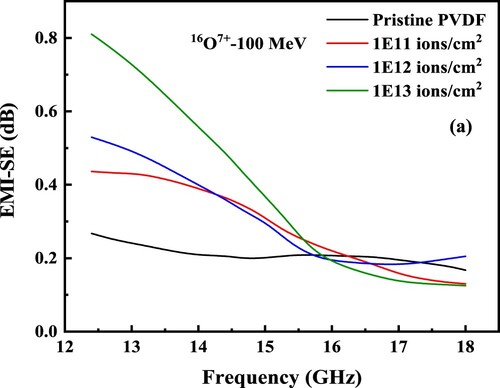
Table 3: Thickness of the PVDF samples before and after irradiation.
Conclusion
This study utilized a thin film applicator to develop PVDF thin films through solution casting, then exposed them to 100 MeV 16O7+ ion beam at varying fluences. The irradiation induced changes in XRD peaks, revealing lattice alterations, heightened dislocation density, strain, and reduced crystallinity. FESEM images illustrated an amorphous phase and grain-like structures due to ion energy transfer. Dielectric properties variations, linked to free radicals and charge relaxation, while decreasing ϵ′′ at higher frequencies suggested charge alignment issues. Ion beam irradiation intricately modified both the structure and electrical properties of PVDF thin films, offering potential applications in EMI shielding.
Author’s contribution
All authors acknowledge their respective contributions to the paper, including study conception and design. Santhoshkumar Dani and Arshad A. H undertook the responsibilities of data collection, analysis, and interpretation of results. The entire author team collectively reviewed the outcomes and unanimously endorsed the final draft of the manuscript.
Acknowledgment
The authors express their gratitude to Prof. K.C. James Raju and Prof. S.V.S. Nageswar Rao, Centre for Advanced Studies in Electronic Science and Technology, University of Hyderabad, for generously providing the facilities for EMI-SE measurements. Additionally, one of the authors extends thanks to the Inter-University Accelerator Centre (IUAC), New Delhi, for granting a fellowship under project No. UFR-70320. The authors are thankful to the IUAC personnel for providing beam time under BTR1-68127.
Disclosure statement
No potential conflict of interest was reported by the author(s).
Data availability statement
The data that support the findings of this study are available from the corresponding author, U V Khadke, upon reasonable request.
References
- Kabir, E.; Khatun, M.; Nasrin, L.; Raihan, M.J.; Rahman, M. Pure β-Phase Formation in Polyvinylidene Fluoride (PVDF)-Carbon Nanotube Composites. J. Phys. D. Appl. Phys. 2017, 50 (16), 163002. DOI:10.1088/1361-6463/aa5f85.
- Tansel, T. High Beta-Phase Processing of Polyvinylidene Fluoride for Pyroelectric Applications. J. Polym. Res. 2020, 27, 1–5. DOI:10.1007/s10965-020-02073-w.
- Ruan, L.; Yao, X.; Chang, Y.; Zhou, L.; Qin, G.; Zhang, X. Properties and Applications of the β Phase Poly(Vinylidene Fluoride). Polymers 2018, 10 (3), 228. DOI:10.3390/polym10030228.
- Patil, A.H.; Khanam, B.R.; Dani, S.; Kulkarni, S.S.; Kalyani, S.; Khadke, U.V. Enhancement in Energy Loss of Relativistic Electrons in Ferroelectric PVDF Above Phase Transition. Polymer Bull. 2023, 80 (6), 6851–6867. DOI:10.1007/s00289-022-04399-5.
- Prakash, O.; Mhatre, A.M.; Tripathi, R.; Pandey, A.K.; Yadav, P.K.; Khan, S.A.; Maiti, P. Lithium-Irradiated Poly(Vinylidene Fluoride) Nanohybrid Membrane for Radionuclide Waste Management and Tracing. ACS Appl. Polym. Mater. 2021, 3 (4), 2005–2017. DOI:10.1021/acsapm.1c00070.
- Conrad, E.E. Radiation effects on dielectric materials. Conference on Electrical Insulation & Dielectric Phenomena - Annual Report 1972, Buck Hill Falls, PA, USA, pp (1972) 320–323. DOI:10.1109/CEIDP.1972.7734181.
- Kanjilal, D. Swift heavy ion-induced modification and track formation in materials. Curr. Sci. 2001, 80, 1560–1566.
- Mahendia, S.; Chahal, R. P.; Tomar, A. K.; Wadhwa, H.; Kumar, S. Springer Series on Polymer and Composite Materials. Radiat. Eff. Polym. Mat. 2019, 141–192. DOI:10.1007/978-3-030-05770-1_5.
- Weng, G.M.; Li, J.; Alhabeb, M. et al. Layer-by-layer Assembly of Cross-Functional Semi-Transparent MXene-Carbon Nanotubes Composite Films for Next-Generation Electromagnetic Interference Shielding. AdvFuncti Mater 2018, 28. DOI:10.1002/adfm.20180.
- Yao, B.; Hong, W.; Chen, T. et al. Highly Stretchable Polymer Composite with Strain-Enhanced Electromagnetic Interference Shielding Effectiveness. Advan. Mater. 2020, 32, e1907499. DOI:10.1002/adma.201907499.
- Qin, Q.; Hu, Y.; Guo, S.; Yang, Y.; Lei, T.; Cui, Z.; Wang, H.; Qin, S. PVDF-based Composites for Electromagnetic Shielding Application: A Review. J. Polymer Res. 2023, 30 (3), 130. DOI:10.1007/s10965-023-03506-y.
- Liu, S.; Qin, S.; Jiang, Y. et al. Lightweight High-Performance Carbon-Polymer Nanocomposites for Electromagnetic Interference Shielding. Compos. Part A Appl. Sci. 2021, 145. DOI:10.1016/j.compositesa.2021.106376.
- Liang, L.; Xu, P.; Wang, Y. Flexible Polyvinylidene Fuorideflm with Alternating Oriented Graphene/Ni Nanochains for Electromagnetic Interference Shielding and Thermal Management. Chem. Eng. J. 2020, 395, 125209.
- Kumar, G.S.; Vishnupriya, D.; Suresh Chary, K.; Umasankar Patro, T. High Dielectric Permittivity and Improved Mechanical and Thermal Properties of Poly(Vinylidene Fluoride) Composites with low Carbon Nanotube Content: Effect of Composite Processing on Phase Behavior and Dielectric Properties. Nanotechnology 2016, 27 (38), 385702. DOI:10.1088/0957-4484/27/38/385702.
- Harish Kumar, A.; Basheer Ahamed, M.; Deshmukh, K.; Sirajuddeen, M.S. Morphology, Dielectric and EMI Shielding Characteristics of Graphene Nanoplatelets, Montmorillonite Nanoclay and Titanium Dioxide Nanoparticles Reinforced Polyvinylidene Fluoride Nanocomposites. J. Inorg. Organomet Polym. Mater. 2021, 31, 2003–2016. DOI:10.1007/s10904-020-01869-z.
- Lee, S.; Park, J.; Kim, M.C. et al. Polyvinylidene Fluoride Core–Shell Nanofiber Membranes with Highly Conductive Shells for Electromagnetic Interference Shielding. ACS Appl. Polym. Mater. 2021, 13, 25428–25437. DOI:10.1021/acsami.1c06230.
- Joshi, A.; Bajaj, A.; Singh, R.; Alegaonkar, P.S.; Balasubramanian, K.; Datar, S. Graphene Nanoribbon–PVA Composite as EMI Shielding Material in the X Band. Nanotechnology 2013, 24 (45), 455705. DOI:10.1088/0957-4484/24/45/455705.
- Petrychuk, M.V.; Oliynyk, V.V.; Zagorodnii, V.V.; Ogurtsov, N.A.; Pud, A.A. PVDF/Poly (3-Methylthiophene)/MWCNT Nanocomposites for EMI Shielding in the Microwave Range. Heliyon 2023. DOI:10.1016/j.heliyon.2023.e23101.
- Zhao, Y.; Hou, J.; Bai, Z.; Yang, Y.; Guo, X.; Cheng, H.; Zhao, Z.; Zhang, X.; Chen, J.; Shen, C. Facile Preparation of Lightweight PE/PVDF/Fe3O4/CNTs Nanocomposite Foams with High Conductivity for Efficient Electromagnetic Interference Shielding. Compos. A. Appl. Sci. 2020, 139, 106095. DOI:10.1016/j.compositesa.2020.106095.
- Marka, S.K.; Sindam, B.; Raju, K.C.J.; Srikanth, V.V. Flexible few-Layered Graphene/Poly Vinyl Alcohol Composite Sheets: Synthesis, Characterization and EMI Shielding in X-Band Through the Absorption Mechanism. RSC Advan. 2015, 5 (46), 36498–36506. DOI:10.1039/C5RA04038H.
- Kumar, G. S.; Vishnupriya, D.; Antao, R.; Umasankar Patro, T. Carbon Nanotube-Poly (Vinylidene Fluoride) Composite Films for Strain-Sensing Applications. In MSF, vol. 909, pp. 237-242. Trans Tech Publications Ltd, 2017. DOI:10.4028/www.scientific.net/MSF.909.237.
- Alotaibi, A.; Anwar, S. Direct and Extended Piezoresistive and Piezoelectric Strain Fusion for a Wide Band PVDF/MWCNT-Based 3D Force Sensor. IEEE Access 2021, 9, 162156–162174. DOI:10.1109/ACCESS.2021.3129319.
- Rajeevan, S.; John, S.; George, S.C. Polyvinylidene Fluoride: A Multifunctional Polymer in Supercapacitor Applications. J. Power Sources 2021, 504, 230037. DOI:10.1016/j.jpowsour.2021.230037.
- Zhao, M.; Fu, Q.; Hou, Y.; Luo, L.; Li, W. BaTiO3/MWNTs/Polyvinylidene Fluoride Ternary Dielectric Composites with Excellent Dielectric Property, High Breakdown Strength, and High-Energy Storage Density. ACS Omega 2019, 4 (1), 1000–1006. DOI:10.1021/acsomega.8b02504.
- Arshad, A.H.; Dani, S.; Kulkarni, S.S.; Khadke, U.V. Dielectric Spectroscopy of Ferroelectric Crossbred PVDF–TiO2 Polymer Composite Thin Films. J. Sci. Res. 2023, 15 (1), 95–102.
- Cullity, B.D. Elements of X-Ray Diffraction. London: Addison-Wesley Publishing, 1956.
- Sharma, M.; Gaur, A.; Kumar Quamara, J. Effect of 40 MeV Li3+ ion Irradiation on Dielectric and Ferroelectric Properties of (1-x)PVDF/(x)BaTiO3 Nanocomposites Vacuum 2019, 167, 344–351. DOI:10.1016/j.vacuum.2019.06.032.
- Sharma, M.; Gaur, A.; Quamara, J.K. Effect of 80 MeV O6+ ion Irradiation on Structural, Morphological, Dielectric, and Ferroelectric Properties of (1-x)PVDF/(x)BaTiO3 Nanocomposites. Ionics 2020, 26, 471–481. DOI:10.1007/s11581-019-03163-6.
- Fink, D. Fundamentals of ion-Irradiated Polymers, In: Springer Series in Materials Science. DOI:10.1007/978-3-662-07326-1.
- Rana, D.S.; Chaturvedi, D.K.; Quamara, J.K. Morphology, Crystalline Structure, and Chemical Properties of 100 MeV Ag-ion Beam Irradiated Polyvinylidene Fluoride (PVDF) Thin Film. J. Optoelectron. Adv. Mater 2009, 11 (5), 705–712.
- Dani, S.; Channabasavanna, P.N.; Kulkarni, S.; Manohara, S.R.; Udayakumar, K. The Electromagnetic Interference Shielding Effectiveness and Dielectric Response of PVDF-nTiO2Nanocomposites Thin Films. Trends Sci. 2022, 19 (21), 3046–3046. DOI:10.48048/tis.2022.3046.
- Arshad, A.H.; Dani, S.; Kulkarni, S.S.; Khadke, U.V. Dielectric Spectroscopy of Ferroelectric Crossbred PVDF-TiO 2 Polymer Composite Thin Films. J. Sci. Res. 2023, 15 (1). DOI:10.3329/jsr.v15il.60132.
- Biswas, A.; Gupta, R.; Kumar, N.; Avasthi, D.K.; Singh, J.P.; Lotha, S.; Fink, D.; Paul, S.N.; Bose, S.K. Recrystallization in Polyvinylidene Fluoride upon low Fluence Swift Heavy ion Impact. Appl. Phys. Lett. 2009, 78 (26), 4136–4138. DOI:10.1063/1.1376664.
- Ramola, R.C.; Subhash, C.; Rana, J.M.S.; Sonkawade, R.G.; Kulriya, P.K.; Fouran, S.; Avasthi, D.K.; Annapoorni, S. A Comparative Study of the Effect of O+7 ion Beam on Polypyrrole and CR-39 (DOP) Polymers. J. Phys. D Appl. Phys. 2008, 41, 115411. DOI:10.1088/0022-3727/41/11/115411.
- Agarwal, P.R.; Kumar, R.; Kumari, S.; Dhakate, S.R. Three-dimensional and Highly Ordered Porous Carbon–MnO2 Composite Foam for Excellent Electromagnetic Interference Shielding Efficiency. RSC Advances 2016, 6, 100713–100722. DOI:10.1039/C6RA23127F.
- Ye, F.; Zhang, L.; Yin, X.; Zhang, Y.; Kong, L.; Liu, Y.; Cheng, L. Dielectric and Microwave-Absorption Properties of SiC Nanoparticle/SiBCN Composite Ceramics. J. Eur. Ceram. Soc. 2014, 34, 205–215. DOI:10.1016/j.jeurceramsoc.2013.08.005.
- Song, Y.; Liu, X.; Gao, Z.; Wang, Z.; Hu, Y.; Yang, K.; Zhao, Z.; Lan, D.; Wu, G. Core-shell Ag@C Spheres Derived from Ag-MOFs with Tunable Ligand Exchanging Phase Inversion for Electromagnetic Wave Absorption. J. Colloid Interface Sci. 2022, 620, 263–272. DOI:10.1016/j.jcis.2022.04.012.
- Logesh, G.; Srishilan, C.; Sabu, U.; Prasad, K.; Rashad, M.; Joseph, A.; Raju, K.J.; Balasubramanian, M. Carbon Fiber Reinforced Composites from Industrial Waste for Microwave Absorption and Electromagnetic Interference Shielding Applications. Ceram. Int. 2023, 49 (2), 1922–1931. DOI:10.1016/j.ceramint.2022.09.157.
- Zha, X.-J.; Pu, J.-H.; Ma, L.-F.; Li, T.; Bao, R.-Y.; Bai, L.; Liu, Z.-Y.; Yang, M.-B.; Yang, W. A Particular Interfacial Strategy in PVDF/OBC/MWCNT Nanocomposites for High Dielectric Performance and Electromagnetic Interference Shielding. Compos. - A: Appl. Sci. 2018, 105, 118–125. DOI:10.1016/j.compositesa.2017.11.011.



